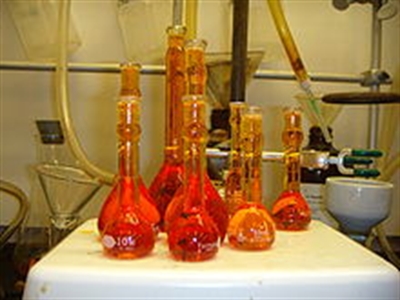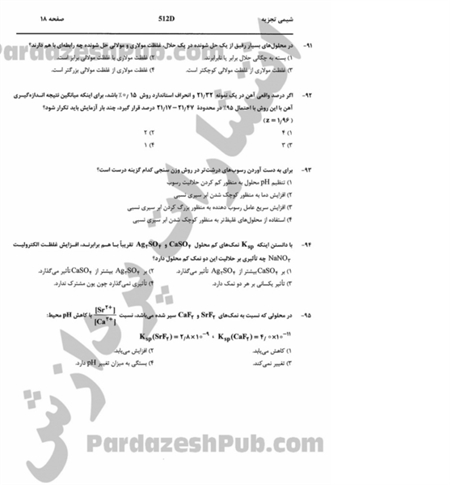شیمی تجزیه
شیمی تجزیه به عنوان یک بخش کاربردی در علوم مختلف است هدف از این وبلاگ ارائه روشهای تجزیه ای پرکاربرد است. https://www.instagram.com/_u/ShimiGeramشیمی تجزیه
شیمی تجزیه به عنوان یک بخش کاربردی در علوم مختلف است هدف از این وبلاگ ارائه روشهای تجزیه ای پرکاربرد است. https://www.instagram.com/_u/ShimiGeramآزمایش عجیب
یکی از جالب ترین آزمایش های شیمی ک انجام دادم واکنش نوشابه با قرص نعنا بود ک باعث شد یک شیشه نوشابه 1.5 لیتری پپسی(اصل) حدود بیست متر بالا بره.قرص نعنا در مقابله با نوشابه واکنش شیمیایی فوق العاده نشون می ده. وقتی قرص نعنا را درون نوشابه می اندازیم اجتماع گاز نوشابه چندین برابر می شه.یک واکنش فورانی بین نوشابه گازد... یکی از جالب ترین آزمایش های شیمی ک انجام دادم واکنش نوشابه با قرص نعنا بود ک باعث شد یک شیشه نوشابه 1.5 لیتری پپسی(اصل) حدود بیست متر بالا بره.قرص نعنا در مقابله با نوشابه واکنش شیمیایی فوق العاده نشون می ده. وقتی قرص نعنا را درون نوشابه می اندازیم اجتماع گاز نوشابه چندین برابر می شه.یک واکنش فورانی بین نوشابه گازدار و قرص آبنباتی نعنا باعث پاشیدن نوشابه ب بیرون از ظرف میشه.خلل و فرج های متعدد و بسیار کوچک رو سطح آبنبات هست خارج شدن حباب های گاز CO2 را از نوشابه تسریع می کنه.که این باعث تجمع گاز در آنها می شه همچنین باعث افزایش سطح تماس بین واکنشگر و مورد واکنش میشود ک واکنش بنزوات پتاسیم،آسپارتام و گاز موجود در نوشابه رو با ژلاتین و صمغ عربی و دیگر عناصر آبنبات تشکیل می دهد. آزمایشات نشون می دن ک قرص هایی باطعم میوه های گوناگون ک دارای پوشش مومی و سطح صافی است ب سختی واکنش می دهند ولی قرص نعنا بدون هیچ پوششی وقتی ب سودا می رسد باعث فوران های کف مانند پر انرژی می شود. همچنین با نوشابه Coca cola lite این واکنش بهتر انجام میشه.CO2 را از نوشابه تسریع می کنه.که این باعث تجمع گاز در آنها می شه همچنین باعث افزایش سطح تماس بین واکنشگر و مورد واکنش میشود ک واکنش بنزوات پتاسیم،آسپارتام و گاز موجود در نوشابه رو با ژلاتین و صمغ عربی و دیگر عناصر آبنبات تشکیل می دهد. آزمایشات نشون می دن ک قرص هایی باطعم میوه های گوناگون ک دارای پوشش مومی و سطح صافی است ب سختی واکنش می دهند ولی قرص نعنا بدون هیچ پوششی وقتی ب سودا می رسد باعث فوران های کف مانند پر انرژی می شود. همچنین با نوشابه Coca cola lite این واکنش بهتر انجام میشه.
تیزآب سلطانی
(به انگلیسی: Aqua regia) محلولی بسیار خورنده و دودکنندهٔ زرد یا قرمز رنگ است. این محلول از تازهمخلوط نیتریک اسید غلیظ و هیدروکلریک اسید غلیظ که معمولاً به نسبت حجمی یک به سه میباشند، به دست میآید.
این ترکیب میتواند فلزات نادری چون طلا و پلاتین را در خود حل کند، هرچند تانتالیوم، ایریدیوم،اسمیوم،تیتانیوم و فلزات کمشمار دیگری توان ایستادگی در برابر آن را دارند.
چرا تیزآب جلد را می سوزاند؟
برخی از تیزابها جلد انسان را می سوزاند زیرا تمایل شدید به جذب آب دارند. در فرایند جذب آب مقدار زیادی نیز گرما تولید می شود و چون سلول زنده محتوی آب است، تیزاب قوی با آن واکنش انجام می دهد و سلول را میکشد آب آنرا جذب و سوختگی شدید بوجود می آورد.
تیزاب کلرئیدریک، تیزاب سولفریک و تیزاب نیتریک هر سه بسیار قوی و خطر ناک هستند. آنها تیزابهای غیر عضوی نامیده می شوند زیرا از مواد غیر زنده ساخته شده اند. بسیاری از تیزابها عضوی و تیزابهای که به طور طبیعی وجود دارند نسبتاً ضعیف هستند. سرکه و آبلیمو از این نوع تیزاب ها به شمار می روند.
افرادی که در صعنت با تیزابهای قوی سر و کار دارند از لباس و عینک محافظ استفاده می کنند. برای مخلوط کردن آب و تیزاب باید تیزاب را به آرامی و کم کم داخل آب ریخت اما هرگز آب را بالای تیزاب نریزید چون باعث انفجار می شود. اگر بطور اتفاقی تیزاب روی پوست شما بریزد، پوست تان را اول با آب و بعد با محلول آمونیاک ضعیف بشوئید.
برای تهیه تیزاب سلطانی، اسید نیتریک غلیظ و اسید کلریدریک غلیظ را به نسبت های 1 و 3 با هم مخلوط میکنیم و به هم میزنیم. اگر بخواهیم محلول را برای مدتی نگه داریم، بهتر است یک حجم آب به آن اضافه کنیم؛ در غیر این صورت کلر و سایر گازهای نا مطبوع در آن تولید خواهد شد.

خب حالا میخوام بدونم تیزآب در صنعت در چه جاهایی کاربرد داره و به کمک دوستان احتیاج دارم...
HPLC - High Performance Liquid Chromatography
What Is HPLC (High Performance Liquid Chromatography)?
Brief History and Definition
Liquid chromatography was defined in the early 1900s by the work of the Russian
botanist, Mikhail S. Tswett. His pioneering studies focused on separating
compounds [leaf pigments], extracted from plants using a solvent, in a column
packed with particles.
Tswett filled an open glass column with particles. Two specific materials that he found useful were powdered chalk [calcium carbonate] and alumina. He poured his sample [solvent extract of homogenized plant leaves] into the column and allowed it to pass into the particle bed. This was followed by pure solvent. As the sample passed down through the column by gravity, different colored bands could be seen separating because some components were moving faster than others. He related these separated, different-colored bands to the different compounds that were originally contained in the sample. He had created an analytical separation of these compounds based on the differing strength of each compound’s chemical attraction to the particles. The compounds that were more strongly attracted to the particles slowed down, while other compounds more strongly attracted to the solvent moved faster. This process can be described as follows: the compounds contained in the sample distribute, or partition differently between the moving solvent, called the mobile phase, and the particles, called the stationary phase. This causes each compound to move at a different speed, thus creating a separation of the compounds.
Tswett coined the name chromatography [from the Greek words chroma, meaning color, and graph, meaning writing—literally, color writing] to describe his colorful experiment. [Curiously, the Russian name Tswett means color.] Today, liquid chromatography, in its various forms, has become one of the most powerful tools in analytical chemistry.

Liquid Chromatography (LC)
Techniques
Liquid chromatography can be performed using planar [Techniques 1 and 2] or
column techniques [Technique 3]. Column liquid chromatography is the most
powerful and has the highest capacity for sample. In all cases, the sample
first must be dissolved in a liquid that is then transported either onto, or
into, the chromatographic device.
Technique 1. The sample is spotted onto, and then flows through, a thin layer of chromatographic particles [stationary phase] fixed onto the surface of a glass plate [Figure B]. The bottom edge of the plate is placed in a solvent. Flow is created by capillary action as the solvent [mobile phase] diffuses into the dry particle layer and moves up the glass plate. This technique is called thin-layer chromatography or TLC.

Figure B: Thin-layer Chromatography
Note that the black sample is a mixture of FD&C yellow, red and blue food dyes that has been chromatographically separated.
Technique 2. In Figure C, samples are spotted onto paper [stationary phase]. Solvent [mobile phase] is then added to the center of the spot to create an outward radial flow. This is a form of paper chromatography. [Classic paper chromatography is performed in a manner similar to that of TLC with linear flow.] In the upper image, the same black FD&C dye sample is applied to the paper.

Figure C: Paper Chromatography
Notice the difference in separation power for this particular paper when compared to the TLC plate. The green ring indicates that the paper cannot separate the yellow and blue dyes from each other, but it could separate those dyes from the red dyes. In the bottom image, a green sample, made up of the same yellow and blue dyes, is applied to the paper. As you would predict, the paper cannot separate the two dyes. In the middle, a purple sample, made up of red and blue dyes, was applied to the paper. They are well separated.
Technique 3. In this, the most powerful approach, the sample passes through a column or a cartridge device containing appropriate particles [stationary phase]. These particles are called the chromatographic packing material. Solvent [mobile phase] flows through the device. In solid-phase extraction [SPE], the sample is loaded onto the cartridge and the solvent stream carries the sample through the device. As in Tswett’s experiment, the compounds in the sample are then separated by traveling at different individual speeds through the device. Here the black sample is loaded onto a cartridge. Different solvents are used in each step to create the separation.
Figure D-1: Column Chromatography – Solid-Phase Extraction [SPE]
When the cartridge format is utilized, there are several ways to achieve flow. Gravity or vacuum can be used for columns that are not designed to withstand pressure. Typically, the particles in this case are larger in diameter [> 50 microns] so that there is less resistance to flow. Open glass columns [Tswett’s experiment] are an example of this. In addition, small plastic columns, typically in the shape of syringe barrels, can be filled with packing-material particles and used to perform sample preparation. This is called solid-phase extraction [SPE]. Here, the chromatographic device, called a cartridge, is used, usually with vacuum-assisted flow, to clean up a very complex sample before it is analyzed further.
Smaller particle sizes [<10 microns] are required to improve separation power. However, smaller particles have greater resistance to flow, so higher pressures are needed to create the desired solvent flow rate. Pumps and columns designed to withstand high pressure are necessary. When moderate to high pressure is used to flow the solvent through the chromatographic column, the technique is called HPLC.
What Is High Performance Liquid
Chromatography (HPLC)?
The acronym HPLC,
coined by the late Prof. Csaba Horváth for his 1970 Pittcon paper, originally
indicated the fact that high pressure was used to generate the flow required
for liquid chromatography in packed columns. In the beginning, pumps only had a
pressure capability of 500 psi [35 bar]. This was called high pressure liquid
chromatography, or HPLC. The early 1970s saw a tremendous leap in technology.
These new HPLC instruments could develop up to 6,000 psi [400 bar] of pressure,
and incorporated improved injectors, detectors, and columns. HPLC really began
to take hold in the mid-to late-1970s. With continued advances in performance
during this time [smaller particles, even higher pressure], the acronym
HPLC remained the same, but the name was changed to high performance liquid
chromatography.
High performance liquid chromatography is now one of the most powerful tools in analytical chemistry. It has the ability to separate, identify, and quantitate the compounds that are present in any sample that can be dissolved in a liquid. Today, compounds in trace concentrations as low as parts per trillion [ppt] may easily be identified. HPLC can be, and has been, applied to just about any sample, such as pharmaceuticals, food, nutraceuticals, cosmetics, environmental matrices, forensic samples, and industrial chemicals.

Figure D-2: HPLC Column
What Is UltraPerformance Liquid
Chromatography (UPLC Technology)?
In 2004, further advances in instrumentation and column technology were made to
achieve very significant increases in resolution, speed, and sensitivity in
liquid chromatography. Columns with smaller particles [1.7 micron] and
instrumentation with specialized capabilities designed to deliver mobile phase
at 15,000 psi [1,000 bar] were needed to achieve a new level of performance. A
new system had to be holistically created to perform ultra-performance liquid
chromatography, now known as UPLC technology.
Basic research is being conducted today by scientists working with columns containing even smaller 1-micron-diameter particles and instrumentation capable of performing at 100,000 psi [6,800 bar]. This provides a glimpse of what we may expect in the future.
چرا کرم های چند کاره!!! تان را حذف کردید؟
آفرین بر شما ، مطلب کاربردی برای آغاز یک کار کاملا علمی است. چه زیبا می شد اگر مرجعهای اونو هم میگذاشتید و یک ویرایش ساده هم انجام میدادید و این لینک آموزش و مطالب دیگر رو هم یک کاریش میکردید!
یا علی
م. حجتی
واکنش کارتونی
سلام واکنش جیوه (II) تیوسیانات (Hg(SCN)2) و آمونیوم کرومات (NH4)2CrO4 یک واکنش استثنایی است. به نظر شما علت خارج العاده بودن این واکنش چیست؟ برای انجام این واکنش در مرکز شکوه رعایت کدام نکات ایمنی از اهمیت زیادی برخوردار است؟ ویدئو زیر این واکنش جالب را نشان میدهد.
http://uploadkon.ir/?file=R_رaction chimique surprenante.flv
منابع مرجع دانشگاهی شیمی تجزیه برای آمادگی در آزمون کارشناسی ارشد
« شیمی تجزیه »
)دروس تجزیه 1و2 و شیمی تجزیه دستگاهی(
تعداد سئوالات این درس در آزمون کارشناسی ارشد دانشگاه سراسری 30 سوال و ضریب آن برای گرایش شیمی تجزیه (2) و برای سایر گرایشها (1) میباشد. منابع مهم این درس کتابهای شیمی تجزیه تألیف اسکوگ، هالر، وست و ... میباشند
ادامه مطلب ...آشنایی بیش تر با یه دوست!
EDTA یا همون edta یه دوسته که اسمش بدون فشردگی اتیلن دی آمین تترا استیک اسید(استات) می باشد. مثل خیلی از ما آدمها که دو یا چند اسمه هستیم یا احیانا هنرمندیم و اسم هنری داریم این دوست عزیز هم اسم های دیگه ای دارن که تو صنعت و جاهای دیگه مثل کشاورزی و ... از اون ها یاد میکنن!!... شما عزیزان میتونید این شخصیت شخیص رو در صنایع و علوم مختلف با این اسامی شناسایی و با اونها ملاقات کنید! : VERSENE ACID – TRIPLEX – TRILON

سوالات شیمی تجزیه در آزمون سراسری 91 کارشناسی ارشد
با آرزوی توفیق روز افزون و پیشرفت علمیتان...


